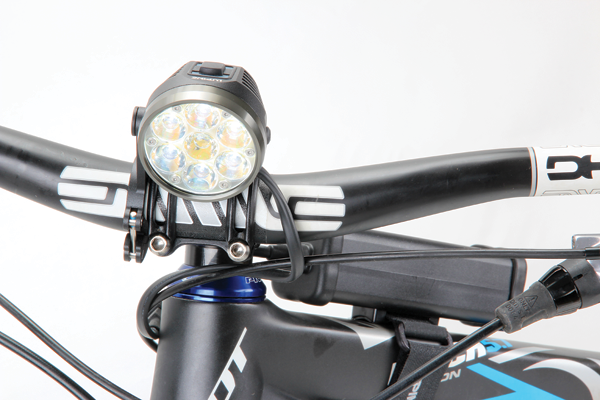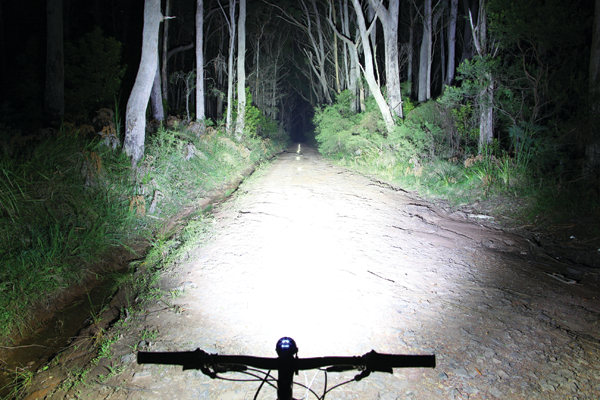LED Lights Review
Winter isn’t far off and when it hits, a good set of lights may be just the ticket if you still want to escape for a mid-week MTB ride. Here’s a selection of the latest and brightest LED lighting systems for 2013.
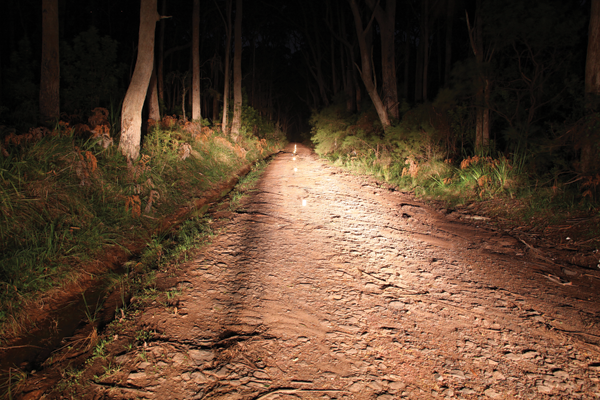
These photos were taken using the same camera settings as the bike lights and should help to put everything in context. First up we have a $20 Dolphin torch, as purchased from the local hardware store (yes, that’s the dim one). Then we have some halogen car headlights on high-beam—that’s two 130-watt H4 globes with aftermarket IPF reflectors and upgraded wiring looms. Now check out how the tiny little LED bike lights compare...
Note: All of the night-time trail photos were taken on a Canon 5D (28mm lens) with a 20-second exposure at F9 and an ISO of 400. Ten reflectors on the trail are spaced at 10-metre intervals so the furthest is 100 metres away from the light. These images were taken on the same night as our last lighting feature. While they should allow for some comparison from one magazine to the next, there may still be variations due to different print runs.
BRC Ultrastar 1400 $159
Cell Bikes (02) 9565 1899 / www.cellbikes.com.au
Not that long ago a 1,400 lumen bike light would have been at the absolute cutting edge, now you can buy one claiming that sort of output for well under $200. BRC is sold by Cell Bikes and the Ultrastar 1400 is their range-topping light designed specifically for off-road use—it even comes with a warning not to use it on the road in the high-beam setting.
The beam produced by the Ultrastar is certainly off-road worthy. While it mightn’t be as bright as the other affordable lights that we looked at, it does offer a smooth beam pattern that’s free of hot-spots and distracting cut-offs. It’s pretty easy on your eyes and the beam is broad enough to run effectively as a handlebar mounted light.
The solid feeling alloy light head mounts directly to the handlebar using an O-ring; it’s simple and works very well. A proper helmet fitting mount is in the works but our kit only came with a camping/caving style head-harness. The helmet mount should be available by the time you read this and will come standard with the kit.
While the bar mount is good, the battery mount leaves a bit to be desired. The battery bag wraps around your stem or frame but the wrap will be too short for fatter frames and they’ve been too skimpy with the velcro. I’d be customising the bag with an extra strap to ensure that it stays put when riding off-road. At least the battery is compact and light.
The Ultrastar may be advertised as an off-road light, but it has an unavoidable flashing mode right between the low and high beams. You could be climbing on low beam and then hit a descent and desperately need more light. To get to high beam you’ll need to cycle through the annoying and potentially dangerous flashing mode. We also found that the longest high-beam burntime was closer to 2:50, not the claimed three and a half hours. Still, this is very respectable given the compact size of the battery.
It’s certainly got some faults but hey, look at the price! The light output is quite good and for the money there are plenty of people who’d overlook the shortcomings.
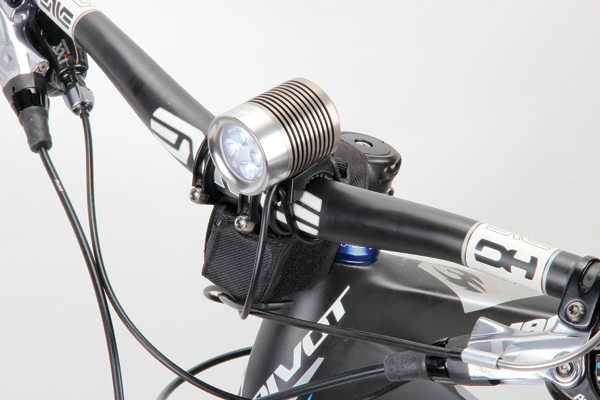
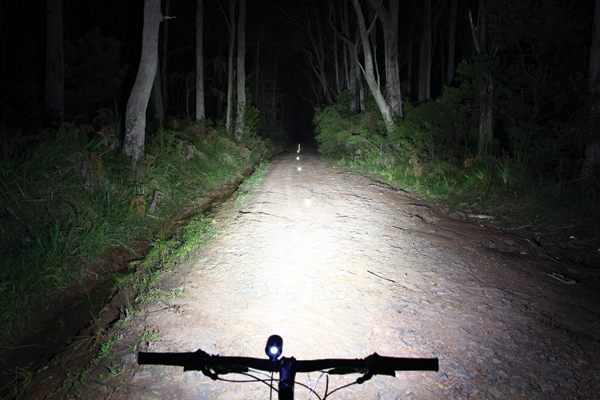
Magicshine MJ-880 $230
Magicshine Australia 1300 7300 990 / www.magicshineledlights.com.au
Magicshine is the brand that broke new ground by taking high-powered LED lights down to extremely affordable price points. While the pricing was great, these lights were usually sourced from international sellers, lacked Australian chargers and faced plenty of reliability issues.
This situation has changed quite a bit and now Magicshine has a dedicated Aussie based distributor. They now come with appropriate chargers and the lights themselves appear to be better finished. The MJ-880 isn’t as cheap as the early Magicshines but it’s also a good deal brighter and any problems can now be managed locally.
Magishine claims a 2,000 lumen light output for this model. This figure seems optimistic to us, as we’ve encountered 1,100 lumen lights that are just as bright. That’s not to say there isn’t enough light – it produces plenty for off-road riding – it’s just a reminder that the claimed figures should always be viewed with some scepticism. Whilst talking light output, the updated MJ-880 U2 should be available by the time you read this and it’s meant to be 10% brighter than the model that we had on test.
The MJ-880 has a very bright central beam that gives it good distance throw. It also offers some spread to the sides but your eyes tend to adjust to the central hot-spot, and this results in a bit of tunnel vision. A beam of this nature is more at home on faster fire roads. It becomes a bit distracting in singletrack and at lower speeds where you’re constantly moving your bars around. The spot beam could work better on your head but the standard kit isn’t supplied with a helmet mount—it’s an optional extra.
Mounting is done using a rubber strap and the wide contoured base on the light head ensures that it doesn’t move around or vibrate on the trail. The mount is also wider than you’d expect, so the light head won’t always point straight ahead if the bars taper quickly in diameter or sweep back as soon as they exit the stem.
On the positive side, the backlit two-button mode control was easy to use. It doubles as an easy to read fuel gauge, changing colour through four different levels to let you know how the battery charge is faring. The 3:50 high-beam burntime exceeded their claimed figure by half an hour and the battery itself, while far from compact, was easy to fit thanks to the tidy rubber strap mounting system. It was also good to see that there wasn’t a distracting flash mode to navigate through (although some may miss it when commuting).
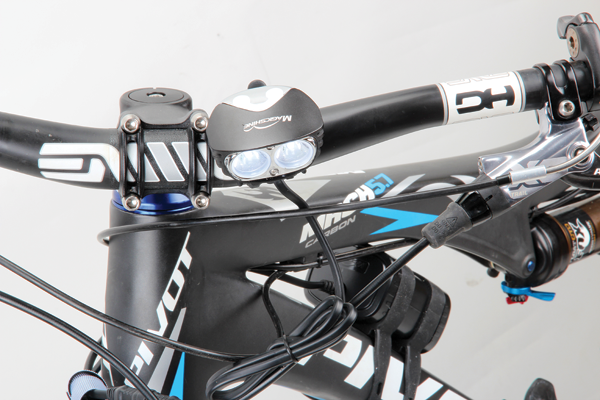
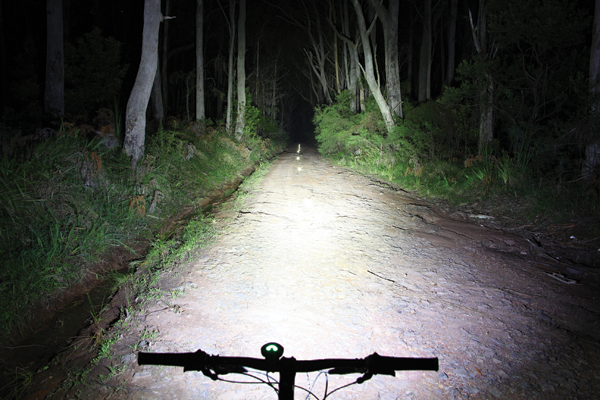
Gemini Olympia $350
Bike Sportz 1800 808 181 / www.gemini-lights.com
Gemini is a relatively affordable lighting brand that’s available through retail bike stores and they come with a 12-month warranty. With a claimed 1,800 lumen output, the Olympia is their top model, and the quality and features of this light belie its price tag. Yes, you’ll find cheaper lights with similar looking finned alloy light heads but it’s the details that make a difference.
We tested the six-cell battery option but you can save $30 and opt for a smaller four-cell version. With burntime of over three and a half hours, the bigger battery will let get you through all but the longest rides on full power—although you may want to step it down a little on the climbs, as the light head gets pretty hot (it has built-in overheat protection that automatically dims the light should you forget). Given the long burntime, the battery is surprisingly small. It’s also nicely packaged; the soft pack is made from sturdy fabric, has a decent length strap and a good-sized velcro patch to keep it secure.
Plenty of lights – both cheap and expensive – use O-ring mounting systems and they can work very well. This was definitely one of the better examples. It features particularly sticky O-rings and the rubberised pad that contacts the handlebar is neither too wide nor narrow. It was fast to fit and secure, with an angle adjustment to compensate for swept-back handlebars. Helmet mounting is also catered for with an easy to fit bracket. The combined weight of the light and mount is just 99g—pretty unobtrusive once it’s on your head.
The beam is well thought out too; while it’s not super-wide, it is very even and filters out gradually to the sides. There’s plenty of light going down the middle of the trail for any high-speed descents. While it has a flashing commuter mode, it’s off the main beam cycle. You can also customise the brightness of each beam setting (there are three in total). The power button is backlit, making it easy to find and it turns from green to amber then red as the battery gets low on power.
For the money the Olympia is a well finished little light that definitely packs enough punch for serious off-road adventures.
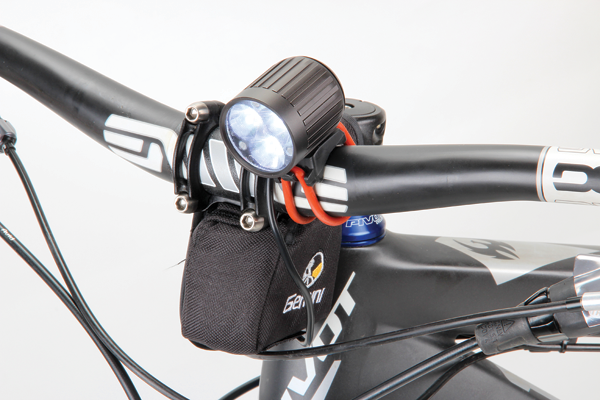
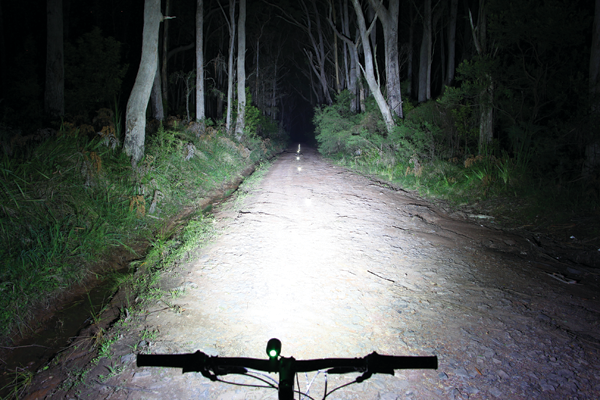
Cygolite Trident X $399
Bikecorp www.bicorp.com.au
The Trident X is a real sleeper of a light. Cygolite rates it at 1,100 lumens; a healthy figure but one that’s starting to sound a little dim these days. In reality it pumps out more light with a better beam pattern than some lights that claim to have almost twice the power.
Rather than just going for an impressively long and bright but narrow beam, the three-in-line LED system offers a broader spread of light to the sides. This provides a better feel for what’s around you and makes the beam less distracting on terrain that requires lots of handlebar input. The beam cuts away more abruptly than some around the sides but the spread is wide enough that this doesn’t pose an issue. While broader than average, it still offers plenty of distance throw for all but the fastest descents. On the whole it’s brighter than the claimed output suggests.
The 130g hard shell battery is tiny and should fit under most handlebar stems. You’ll only get 1:40 on high-beam but there are four power levels on offer that can extend the burntime over 30 hours. Each power level can be custom tuned to suit your needs and there are no flashing modes interrupting the main beam cycle. If you want a flashing mode when commuting, they are easily accessed by holding the main power button down and there’s three flash patterns to choose from—you can even customise the flash speeds.
Want to run in the brighter settings for longer? Cygolite also offers the ‘Xtra’ kit with a bigger battery that takes the high-beam burn time out to 3:20. Whether you go with the minimalist or the bigger option, it’ll be held firmly in place by a broad and sturdy velcro strap. The easy to read fuel gauge on the light also helps you metre the power use as required to get you home.
The main letdown with the Trident was the handlebar mount. The hinged plastic bracket allows tool free mounting but the adhesive backed rubber pads refused to stay in place. In the end I resorted to using a separate shim rather than the stick-on pad that’s supplied. The helmet mount is also a little rudimentary but it does the job. Aside from these nit-picking points the Trident X is a good light for the dollars and it performs better than the spec’s suggest.
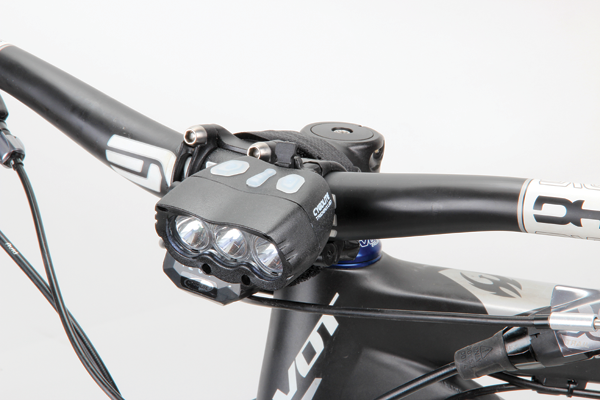
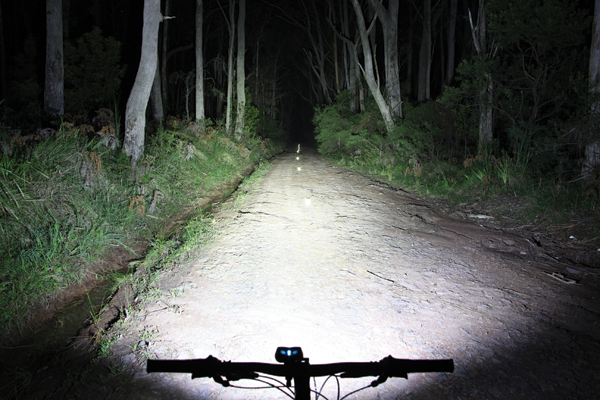
Light and Motion Seca 1700 Race $519
Distributed by JetBlack Products (02) 4560 1200 / www.jetblackproducts.com
While it’s rated at 1,700 lumens, the performance of the Light and Motion Seca far exceeds this figure. On the trail it’s as effective as lights that claim to produce much more light. It really is a case of quality over quantity when it comes to the Seca’s light output.
The six-LED head has strategically focused reflectors, a curved and shaped lens with a frosted lower portion that acts as a diffuser. It creates an asymmetric beam that floods the ground immediately in front of you but it doesn’t waste light by spilling it up towards the sky. Through prudent use of its real-life 1,700 lumens it does a fantastic job of lighting the trail, combining a good distance throw with a very useful spread of light immediately in front and off to the sides. Within the well-metred beam pattern, you won’t find any distracting rings or hot spots. On the trail it had me descending singletrack with as much confidence as the 3,600 lumen lights that we had on review, and in some cases the Seca was easier on the eyes.
At 120g when helmet mounted, the Seca is very light and the battery used for the ‘Race’ version is pretty small too. You’ll only get an hour and a half on full power with the Race battery but they also offer an ‘Enduro’ kit ($599) that takes this figure out to two and a half hours. In either case, Light and Motion provides a massive 50mm wide velcro strap to secure the hard shell battery—this along with the rubberised ends ensures that it won’t rattle or shift when riding.
On the trail, ‘race’ mode proved the most practical. It provides a simple low/high-beam sequence but you can also use the ‘cruise’ mode which offers more settings and a flashing beam.
The light head is secured by a wide rubber strap and you can direct the beam to compensate for different handlebar angles. This system worked without fault, making the Seca very quick and easy to mount. The tiny battery also provided good flexibility when looking for mounting points on suspension bikes and small frame sizes.
My only complaint was with the 130cm long stretch of wire that connects the light to the battery. While this was fine when helmet mounted, it was excessive for handlebar use and left you with a lot of wire to wind up and keep out of the way. I would have been happier with a shorter wire and an extension for helmet mounting. Beyond that, the Seca is a real winner that definitely that punches above its weight.

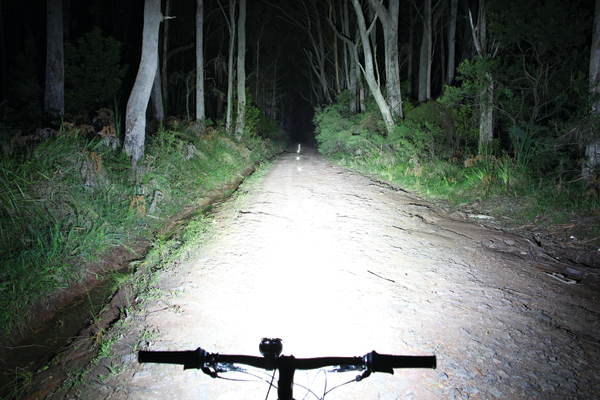
Niterider Pro 3600 $899
Distributed by JetBlack Products (02) 4560 1200 / www.jetblackproducts.com
Last year Niterider’s range-topping light put out 3,000 lumens. Now the same light is up to 3,600 lumens—this light is big in every sense. Weighing in at over 800g, the kit is heavy and every aspect of the light is over-engineered.
It may be chunky but it’s also well thought out and functional. The bracket fits a broad range of handlebar diameters, mounts without tools and the oversized wing-nut makes it easy to tighten whilst wearing full-finger gloves. While the bracket is 24mm wide, you don’t lose any more handlebar space as the light itself is offset and sits in front of the stem.
The battery may be big and heavy but two solid velcro straps and a thick rubber pad ensure that it stays put. The main issue will be finding space for it but the secure mounting system means that you may be able to fit it above the top tube if there isn’t room inside the frame.
So why would you want such a bulky light system when most LEDs continue to shrink in size? The answer is simple; 3,600 lumens of all-conquering light! It’s visibly brighter than last year’s Pro 3000 and puts out a wide enough spread of super-bright light that you can comfortably leave your helmet light at home—even in the singletrack. While the Pro 3,600 is supplied with a helmet mount, the 220g head/bracket weight means it is best left on the bars.
There is a distinct edge around the outer fringe of the beam—it doesn’t fade subtly towards the edge like some lights. I’d typically see this as a weakness but the main light circle is so broad that it doesn’t present an issue; in fact the consistent brightness out towards the outer beam is part of what makes this light so effective. As well as filling the width of the trail from right in front of your wheel, it also fires enough light down the trail to never leave you short at speed.
Even with the massive 11,600mAh battery, you’ll only get an hour and a half at 3,600 lumens. Toning the light back to 1,000 still gives you plenty of light for most situations and the burntime goes up to six hours—just employ the scorching high beam on the descents and you’ll be set. Niterider still employs their DIY tuning system which allows you to hook the system up to a PC and customise the light output—choose a single beam or six different modes and tune each setting to suit. Other high-end lights may offer similar tune-ability but it’s so much easier to do with the DIY program.
This light won’t appeal to weight weenies or anyone who’s after a discreet light kit but at the end of the day, this is one very impressive light.

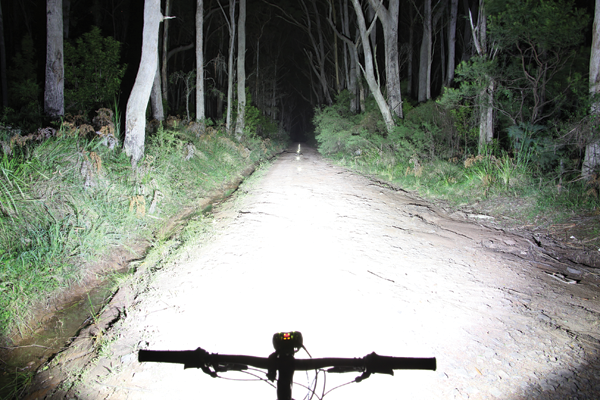
MyTinySun Pro 3600X $899
MyTinySun Australia (02) 8339 0874 / www.mytinysun.com.au
Odd name but MyTinySun is a high-end German brand that specialises in outdoors lighting. The Pro 3600X is their most powerful offering and like two other lights in this feature, it’s said to pump out 3,600 lumens.
In terms of sheer light output, the MyTinySun is up there with the NiteRider Pro and Lupine Betty but its beam is very different. To start with it’s adjustable, as the kit comes with 19, 25 and 42-degree lenses. There’s a pair of each so you can disassemble the front of the light and change the beam spread to suit your trails. It comes fitted with the narrower 19-degree option, which proved equal to or even wider than most LED lights that we’ve reviewed. The 24-degree was my favourite, delivering a really wide spread with plenty of distance throw. Swapping to the 42-degree lens creates a pure flood but really cuts the distance vision – it may be the best option if low-speed techy singletrack is all that you ride. Pick your poison and customise to suit your needs.
Whichever beam pattern you choose, they all have a nice filtered quality that fades out gradually towards the extremities. The central beam doesn’t appear as intense and punchy as the other mega-output lights that we tested but there’s still absolutely tons of light; it’s just more diffused and spread around the trail—less of a cannon but more practical in many ways.
The battery size isn’t excessive and the two-hour-plus high-beam burn time is impressive. You can tune the light output and mode options but you’ll need to have the instruction manual there to reference and read carefully—it’s not exactly intuitive.
In terms of beam quality and adaptability, the Pro 3600X is probably the pick of the bunch but I felt the mounting hardware let it down. The battery bag is comparatively flimsy and the two skinny velcro straps started to show signs of fraying within the test period. The alloy light head is beautifully machined with an O-ring mount; it uses a small lever that stretches the rubber ring and locks it in place. While this could be clever, I found it harder to use and overcomplicated compared with other O-ring mounting systems. The width of the twin-beam head also managed to clash with the stem on some handlebar set-ups and takes up a fair bit of space on the bars. While the remote mode switch can be put within reach of your grip, it’s also bulky and leaves a network of power cable spread across your bars.
The MyTinySun has its idiosyncrasies but it’s a well-engineered light that brings some unique features to the market.
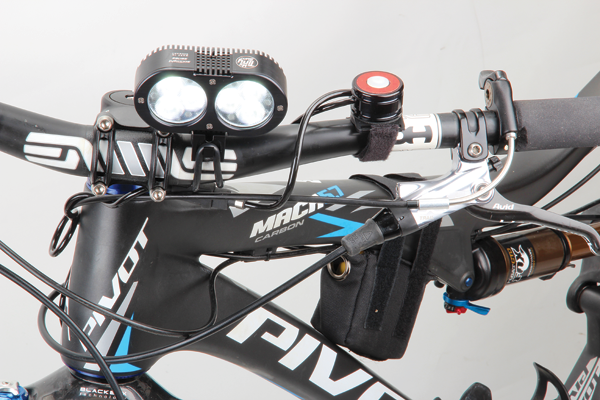
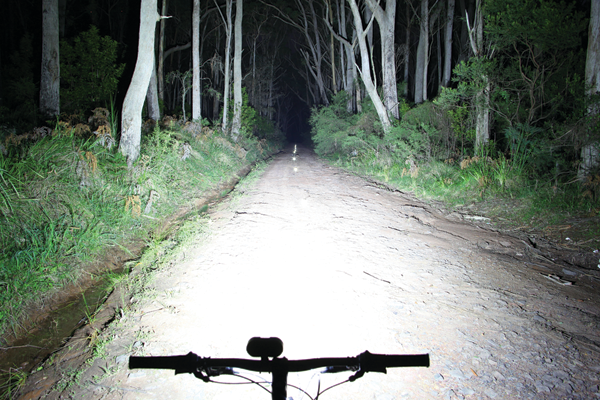
Lupine Betty 12 $1,095
Distributed by Virtuascape www.virtuascape.com.au
Last year the Lupine Betty shocked us with its 2,600 lumen output, now they’ve casually bumped that figure up by another 1,000 lumens! As is usually the case with these German made lights, their lumen ratings are measured and not just theoretical; when they say 3,600 lumens they mean it—this light is insanely bright.
Lupine uses a 26-degree beam spread on the Betty. While this is broader than some of their previous efforts (a few years back the Betty was a 19-degree spot), it’s still throwing a lot of light down into a comparatively narrow beam. This retina burner is great for picking out minute detail a long way up the trail but we can’t help thinking that something producing this much light could do with a wider beam.
Softening the central tunnel of white and spreading it around would offer a better overall feel for the trail and make the Betty easier on the eyes in technical singletrack. As it stands, the beam is better suited for helmet mounted use, although the 181g weight may put some people off in this regard. Fit it to your head and the light will go wherever you look and you won’t have to deal with any abrupt changes in brightness when turning the bars. Perhaps Lupine has the same idea as the Betty 12 kit only comes with a helmet mount and you’ll need to buy the $70 handlebar mount separately (a bit of an ask after buying a $1,095 light set).
Whether you opt for helmet or handlebar mounting, the cool wireless remote will let you change the power output without moving your hands from the bar. What truly won us over with the Betty was the quality of every single item within the kit and how easy it was to live with.
While the 11,200mAh battery isn’t exactly small, it’s narrow enough to fit within most frames and the single broad mounting strap does a surprisingly good job of holding it steady. The battery also incorporates a neat fuel gauge that allows you to check the charge without connecting it to the light head. The helmet mount is secure, adjustable and keeps the weight low to minimise its effect. We did get to try the handlebar mount and it’s pretty amazing; the machined alloy clamp is only 8mm wide and places the light right in front of your stem—it’s tool free and super quick to fit. While there’s no side-to-side adjustment, it mounts so close to the stem that it’s not affected by swept-back bars. Even the soft storage bag is well designed—unlike most there’s actually ample room inside to keep everything stored tidily. As always with Lupine, the Betty is one expensive light but the quality shows.
